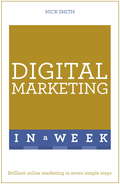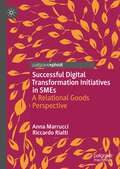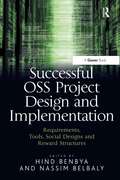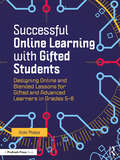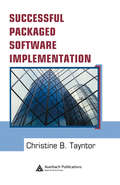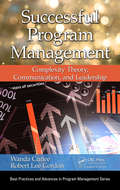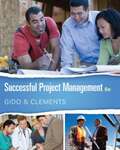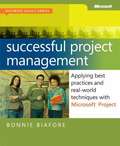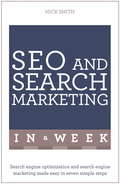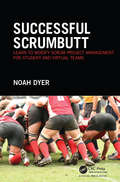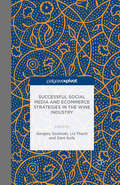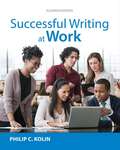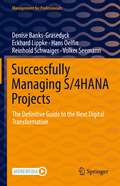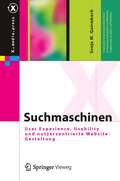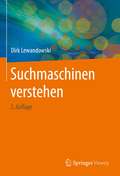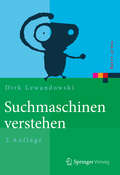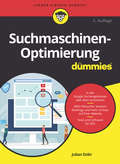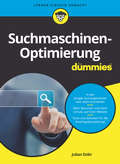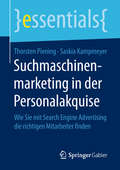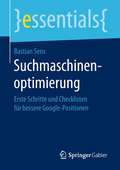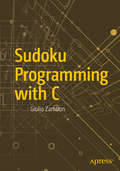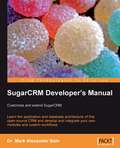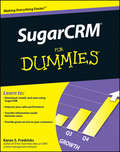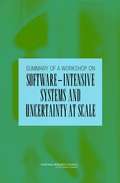- Table View
- List View
Successful Digital Marketing in a Week: Brilliant Online Marketing In Seven Simple Steps
by Nick SmithThe ability to successfully market digitally is crucial to anyone who wants to advance their career.Written by Nick Smith, leading expert on marketing techniques, this book quickly teaches you the insider secrets you need to know to in order to achieve successful digital marketing.The highly motivational 'in a week' structure of the book provides seven straightforward chapters explaining the key points, and at the end there are optional questions to ensure you have taken it all in. There are also cartoons and diagrams throughout, to help make this book a more enjoyable and effective learning experience.So what are you waiting for? Let this book put you on the fast track to success!
Successful Digital Transformation Initiatives in SMEs: A Relational Goods Perspective
by Riccardo Rialti Anna MarrucciWhile it is clear that workforce involvement is fundamental for the success of digital transformation, it is also evident that insufficient attention has been paid to emerging strategies to convince employees to become involved. To do so, this book considers Relational Goods, the intersubjective and reflexive relationships existing between employees, within the DOI framework to evaluate how they influence digital transformation success alongside innovation traits, time and communication channels. The focus for this book is SMEs, as these businesses experience greater difficulties than their larger counterparts in keeping up with the digital revolution. The authors develop the Relational Goods model to a refined DOI framework including the role of relationship and managerial support in the adoption of technologies that may transform the business. It will be of great interest to scholars and students of management, digital transformation and SMEs, as well as HRM professionals.
Successful OSS Project Design and Implementation: Requirements, Tools, Social Designs and Reward Structures
by Hind BenbyaThe open source phenomenon has attracted an increased interest among commercial firms and governments. It is becoming one of the most influential paradigm shifts not only in software development but in social and economic value creation as well. While software development is perhaps the most prominent example of open source, its principles have now been applied across a wide range of product classes, industries and even scientific disciplines. Decision makers at different levels and in a variety of fields need to improve their understanding of the factors that contribute to the Open Source Software (OSS) effectiveness: approaches, tools, social designs, reward structures and metrics. Successful OSS Project Design and Implementation provides a state-of-the-art analysis of OSS design principles, their emergence and success and how they are extending well beyond the domain of software.
Successful Online Learning with Gifted Students: Designing Online and Blended Lessons for Gifted and Advanced Learners in Grades 5–8
by Vicki PhelpsThis innovative, technology-based resource provides those who teach gifted and advanced learners in grades 5–8 with quality, research-based, online lessons, tools, and insights. Throughout, you’ll find ready-to-implement virtual lessons, simulations, and learning modules. You’ll also learn how to create, differentiate, and modify existing lessons through an online platform. In addition, the book offers helpful strategies addressing online student accountability, etiquette, and collaboration, and shares useful tips for communicating with parents. Whether you are looking to enrich learning within the classroom, provide students with extensions outside the classroom, or engage students in distance learning, this book will be invaluable in meeting the needs of your gifted and advanced learners.
Successful Packaged Software Implementation
by Christine B. TayntorSuccessful Packaged Software Implementation guides IT departments through the selection and implementation of packaged software, pointing out potential pitfalls and how to avoid them. Offering a step-by-step approach, this volume begins with an assessment as to whether packaged software is the correct solution. It then analyzes the product selectio
Successful Program Management: Complexity Theory, Communication, and Leadership (Best Practices in Portfolio, Program, and Project Management #7)
by Wanda Curlee Robert Lee GordonComplexity theory is a great, untapped resource in the field of management. Experts agree that it can be a powerful tool for managing complex and virtual programs, but there is little material available to guide program managers on how to use complexity theory to communicate and lead effectively.Filling this void, Successful Program Management: Com
Successful Project Management
by Jack Gido Jim ClementsSUCCESSFUL PROJECT MANAGEMENT, Sixth Edition, presents everything you need to know to work successfully in today's exciting project management environment, from the organization and management of effective project teams to planning, scheduling, and cost management. <p><p>Revised chapters closely align with the PMBOK (Project Management Body of Knowledge) framework to ensure that you are mastering today's best management practices. Coverage of the latest business developments and challenges introduce issues such as project constraints, the project charter, and how projects relate to an organization's strategic plan. <p><p>You even gain experience working with the latest version of today's most popular project management software--Microsoft Project 2013--using the trial version that is available to download on the student companion site.
Successful Project Management: Applying Best Practices and Real-World Techniques with Microsoft® Project
by Bonnie BiaforeLearn best practices and proven methods from project management professionals--and apply these skills as you work with Microsoft® Project. In this practical guide, project management expert Bonnie Biafore shows you how to manage projects efficiently and effectively, sharing the real-world experiences of project managers in several industries. You'll learn how to put the best practices and hard-won lessons of experts to work on your critical projects. Sharpen the skills you need to manage projects expertly--from start to finish Communicate effectively with project stakeholders, management, and team members Apply methods to break down the project into small, manageable pieces Define work assignments, choose resources, and build project schedules Accurately estimate project costs and work with a budget Identify project changes and manage risks Track progress and balance priorities without sacrificing quality Document project history and lessons learned to help improve future projects Project files available on the companion website.
Successful SEO and Search Marketing in a Week: Teach Yourself
by Nick SmithSunday: Understand the functions of the major search engines and what SEO and Search Marketing are and what they doMonday: Learn about your competition and target audience, and organize your website's structureTuesday: Discover the importance of keywords, and how to generate your keyword list and find the best low-cost research toolsWednesday: Learn how to make changes to the pages on your site to increase the chance of rankingThursday: Ensure all of your links are found and indexed by search engines and generate backlinksFriday: Monitor and manage your progress through tools such as Analytics, Webmaster and shortened URLsSaturday: Increase your online presence with search marketing
Successful ScrumButt: Learn to Modify Scrum Project Management for Student and Virtual Teams
by Noah DyerHave you ever seen a promising project get abandoned right when it seemed like it was getting ready to launch, or a project that always seemed like it was going to launch "next month," but took many months or even years before it actually launched? Scrum may be the solution to such woes. It is a project management methodology that, when applied faithfully, will increase the rate at which your project is completed, the enjoyment your team has while working on it, and its commercial success. Converting to scrum can be a challenge for any team, but it is particularly painful for part time, virtual, and student teams. Successful Scrumbutt helps teams quickly learn scrum project management and adapt it to their unique situations. Author Noah Dyer illustrates key techniques for maintaining a team's productivity and enthusiasm for a project across its lifetime in fun, engaging, and slightly irreverent ways. Key Features Learn key techniques for maintaining enthusiasm for your project across its lifetime and have the confidence that every hour spent on your project is having maximum benefit. Includes instructions for using Assembla and other popular and free Scrum software. This will save people time identifying and learning a software package to help implement Scrum principles. Activities to introduce people to Scrum and practice Scrum principles. These are fun ways to learn Scrum in a low pressure atmosphere where delivery and execution are not paramount. Soft Skills Sections help readers understand not only the action to be taken and the principle, but how to effectively communicate with others regarding Scrum practices, particularly problem solving. Excel templates, activities for implementing Scrum in a low tech environment and planning cards that make Scrum planning activities easier and feel more official are included for download and easy printing. Do It Now: Tips for integrating the principle in a chapter right away, even if full Scrum is not yet fully understood and achievable.
Successful Social Media and Ecommerce Strategies in the Wine Industry
by Liz Thach Dani Kolb Gergely SznolnokiThis book focuses on principles and practices in digital wine marketing. By providing a global overview of social media and e-commerce strategies and practices in the wine business, this book allows readers to understand how consumers and producers deal with these modern communication and selling platforms.
Successful Writing At Work (with 2016 MLA Update Card, Eleventh Edition)
by Philip KolinSUCCESSFUL WRITING AT WORK, 11th Edition, is a comprehensive introduction to workplace writing with real-world examples and problems; an easy-to-read style; and thorough guidelines for planning, drafting, revising, editing, formatting, and producing professional documents in the global workplace. After a discussion of the writing process and collaboration, the author explores basic business communications (including e-communications and social media), letters, resumes, and other job search materials; proceeds to how to conduct research and document sources; and ends with guidance on more advanced tasks such as preparing visuals, websites, instructions, procedures, proposals, short and long reports, and presentations. You will learn how to be an effective problem solver at work, understand and write for a global audience, write clear and effective sentences, paragraphs, and documents, and select the best communication technologies to accomplish your goals. Each student text is packaged with a free Cengage Essential Reference Card to the MLA HANDBOOK, Eighth Edition.
Successfully Managing S/4HANA Projects: The Definitive Guide to the Next Digital Transformation (Management for Professionals)
by Denise Banks-Grasedyck Eckhard Lippke Hans Oelfin Reinhold Schwaiger Volker SeemannThe book describes the complete project process in individual steps for SAP S/4HANA project management based on the SAP ACTIVATE implementation methodology. By imparting knowledge based on experience with real SAP projects, the book supports project managers in developing skills and qualifications that will lead them to the successful management of SAP projects. In this context it emphasizes the crucial role of human interaction from the start to the successful completion of projects and provides useful tips on how to recognize and avoid pitfalls.Enriched with a wide range of material such as templates, checklists and practical examples, the book provides concrete guidance for project managers and participants on how to successfully manage ongoing projects. The book is valuable for both beginners and experienced project managers and also gives decision makers and stakeholders an excellent insight into the planning and management of large projects.
Suchmaschinen
by Sonja Monika QuirmbachDie Optimierung der Usability und User Experience einer Suchmaschine ist Basis für die erfolgreiche Entwicklung von Websites. In dem Buch wird gezeigt, welche Methoden eingesetzt werden, um den Suchprozess zu optimieren, wo typische Probleme auftreten und wie sich diese auf die User Experience auswirken. Das Buch leistet Hilfestellung bei Live-Tests mit verschiedenen Versionen, bei der wirtschaftlichen Betrachtung und der Erstellung von Reports mit Web Analytics. Best-Practice-Beispiele helfen sowohl Einsteigern als auch Experten bei der Umsetzung.
Suchmaschinen verstehen
by Dirk LewandowskiSuchmaschinen dienen heute selbstverständlich als Werkzeuge, um Informationen zu recherchieren. Doch wie funktionieren sie genau? Das Buch betrachtet Suchmaschinen aus vier Perspektiven: Technik, Nutzung, Recherche und gesellschaftliche Bedeutung. Es bietet eine klar strukturierte und verständliche Einführung in die Thematik. Zahlreiche Abbildungen erlauben eine schnelle Erfassung des Stoffs.Rankingverfahren und Nutzerverhalten werden dargestellt. Dazu kommen grundlegende Betrachtungen des Suchmaschinenmarkts, der Suchmaschinenoptimierung, der Suchmaschinenwerbung und der Rolle der Suchmaschinen als technische Informationsvermittler. Das Buch richtet sich an alle, die ein umfassendes Verständnis dieser Suchwerkzeuge erlangen wollen, u.a. Suchmaschinenoptimierer*innen, Entwickler*innen, Informationswissenschaftler*innen, Bibliothekarinnen und Bibliothekare sowie Verantwortliche im Online Marketing.Für die dritte Auflage wurde der Text vollständig überarbeitet, ergänzt sowie alle Statistiken und Quellen auf den neuesten Stand gebracht.
Suchmaschinen verstehen (Xpert. Press Ser.)
by Dirk LewandowskiSuchmaschinen sind heute die wichtigsten Werkzeuge, um an Informationen zu gelangen. Wir verwenden Suchmaschinen täglich, meist ohne weiter darüber nachzudenken. Doch wie funktionieren diese Suchwerkzeuge eigentlich genau? Das Buch betrachtet Suchmaschinen aus vier Perspektiven: Technik, Nutzung, Recherche und gesellschaftliche Bedeutung. Es bietet eine klar strukturierte und verständliche Einführung in die Thematik. Zahlreiche Abbildungen erlauben eine schnelle Erfassung des Stoffs.Neben einer ausführlichen Darstellung der in den bekannten Suchmaschinen verwendeten Rankingverfahren wird auch ausführlich auf das Nutzerverhalten eingegangen, das wiederum die Ergebnisdarstellung prägt. Dazu kommen grundlegende Betrachtungen des Suchmaschinenmarktes, der Bedeutung der Suchmaschinenoptimierung und der Rolle der Suchmaschinen als technische Informationsvermittler. Das Buch richtet sich an alle, die mit Suchmaschinen zu tun haben und ein umfassendes Verständnis dieser Suchwerkzeuge erlangen wollen, u.a. Suchmaschinenoptimierer, Entwickler, Informationswissenschaftler, Bibliothekare, Rechercheure in Wissenschaft und Praxis sowie Online-Marketing-Verantwortliche.Für die zweite Auflage wurde der Text vollständig überarbeitet. Neben einem neuen Kapitel zur Suchmaschinenwerbung wurden zahlreiche Abschnitte zu neu aufgekommenen Themen hinzugefügt. Alle Statistiken und Quellen wurden auf den neuesten Stand gebracht.Aus Rezensionen zur ersten Auflage:„Dirk Lewandowski bringt den Fachleuten und Laien näher, was im Hintergrund der Suchmaschine abläuft und wie die Suchergebnisse zustande kommen.“ (Stephan Holländer in Password) „Dirk Lewandowski [...] hat einerseits das Fachwissen, sowohl in die Tiefe zu gehen als auch die Zusammenhänge so verständlich wie möglich zu behandeln. Ein Glücksfall!“ (Jürgen Plieninger in BuB)
Suchmaschinen-Optimierung für Dummies (Für Dummies)
by Julian DzikiSie haben ein Unternehmen gegründet und Ihre Website geht demnächst online? Sie sind gerüstet für zahlreiche Besucher und hoffen auf hohe Umsätze? Dann ist es Zeit für das Feintuning. Dieses Buch zeigt Ihnen, wie Ihre Website von Google besser gefunden wird und wie Sie bei Google ganz nach oben kommen. Finden Sie die richtigen Suchbegriffe und stimmen Sie Ihre Inhalte darauf ab, optimieren Sie Ihre Snippets und unterstützen Sie den Google-Crawler beim Erfassen der Seiten. Zahlreiche Beispiele und Anekdoten aus der Praxis sorgen nicht nur für ein gutes Ranking, sondern auch für Spaß beim Lesen.
Suchmaschinen-Optimierung für Dummies (Für Dummies)
by Julian DzikiSie haben ein Unternehmen gegründet und Ihre Website geht demnächst online? Sie sind gerüstet für zahlreiche Besucher und hoffen auf hohe Umsätze? Dann ist es Zeit für das Feintuning. Dieses Buch zeigt Ihnen, wie Ihre Website von Google besser gefunden wird und wie Sie bei Google ganz nach oben kommen. Finden Sie die richtigen Suchbegriffe und stimmen Sie Ihre Inhalte darauf ab, optimieren Sie Ihre Snippets und unterstützen Sie den Google-Crawler beim Erfassen der Seiten. Zahlreiche Beispiele und Anekdoten aus der SEO-Praxis sorgen für ein gutes Ranking und für Spaß beim Lesen.
Suchmaschinenmarketing in der Personalakquise: Wie Sie mit Search Engine Advertising die richtigen Mitarbeiter finden (essentials)
by Thorsten Piening Saskia KampmeyerThorsten Piening und Saskia Kampmeyer zeigen in diesem essential kompakt und auf den Punkt gebracht, wie Unternehmen im Internet neue Mitarbeiter gewinnen und insbesondere Search Engine Advertising (SEA) zielführend dafür nutzen können. Die Autoren erklären, wie Google und Co. die Candidate Journey effektiv unterstützen können und wie wichtig das kontinuierliche Monitoring mit allen Kennzahlen ist. Angereichert ist das essential mit zahlreichen praktischen Beispielen und konkreten Handlungsempfehlungen.
Suchmaschinenoptimierung: Erste Schritte und Checklisten für bessere Google-Positionen (essentials)
by Bastian SensDieses essential erläutert die wesentlichen Erfolgsfaktoren der Suchmaschinenoptimierung und liefert neben aktuellen Trends auch praxisorientierte Checklisten zur professionellen Einführung von SEO. Dieses Werk enthält zudem zahlreiche Tools für eine effektivere Suchmaschinenoptimierung. Gespickt mit Beispielen aus der Agenturpraxis zeigt der Autor die vier essenziellen Phasen der Suchmaschinenoptimierung. Falls Sie einen Website-Relaunch planen oder Ihre bestehende Website in Google top positionieren möchten, ist dieses Buch die richtige Grundlage.
Suck It In and Smile
by Laurence Beaudoin-MasseA funny, touching look at the life of a social media influencer who starts to question the #goals life she has created for herself. Every day, Ellie motivates her hundreds of thousands of followers to become the best versions of themselves by posting videos of exercise routines and high-protein breakfast recipes. Far from the shy teenager that she was, she is now in a very public relationship with singer Samuel Vanasse, and together they have become one of the most popular influencer couples in the country. She has succeeded. She shines. And yet, Ellie worries that her life is not as flawless as she makes it seem on YouTube and Instagram. Between her obsession with the “ideal weight,” her growing attraction to another man, her family’s disdain for her career as a content creator and a collaboration with another influencer who Ellie can’t stand, a thought haunts her. What if, by trying to become everything she wanted to be, she’s lost herself along the way? Suck it In and Smile is an intimate exploration of our obsession with appearances and the hypocrisies that appear when you must craft the perfect online life. Key Text Features chapters vignettes dialogue
Sudoku Programming with C
by Giulio ZambonLearn how to write computer programs to solve and generate Sudoku puzzles. In Sudoku Programming with C, you will discover every solving strategy and the code to implement them. This practical book provides you with everything you need to write your own books of Sudoku Classic and Samurai puzzles. But be warned: after reading it, you'll discover that the puzzles in your local paper are not so challenging after all! We like Sudokus because they test our capacity to recognize and interpret patterns. But how are the clues generated? Where do those quasi-symmetrical configurations come from? When the author explored the Web to find out, he discovered that there were many sites that explained how to solve Sudokus, but none that told him how create them. He also saw many sites and apps to play Sudoku, but, perhaps not surprising, no indication of how they worked. So, he had to develop his own applications in order to find out. And, from the very start, he decided that he would publish the code for anyone else to use and perhaps tinker with, but the author wrote it in such a way that also lets readers with limited knowledge of programming techniques understand it. In fact, you could decide to start generating thousands of puzzles almost immediately, and go through the explanations of algorithms and techniques later, a bit at a time. The author chose to write the application in 'plain old C' because he wanted to make the code accessible to as many people as possible. In this book, you will find an explanation of all solving strategies, and the code to implement them. Writing the Solver application was more difficult than writing the Generator, because it required designing and implementing each strategy separately. However, the author wanted to include a solving program capable of listing the strategies necessary to solve any particular puzzle. He also wanted to check whether a puzzle was solvable analytically, without any guessing. This book includes the full listings of both the Generator and the Solver, and explanations of all C modules, with walk-throughs and examples. What you'll learn How to model a Sudoku puzzle in C What are the strategies in the main program as well as in the utilities needed How to implement numerous strategies and techniques for Sudoku generating and solving How to solve puzzles How to generate Sudokus What are Samurai Sudokus and how to solve them Who this book is for This book is for readers with limited knowledge of programming techniques. The C code is significant and so it is best to have some prior knowledge of C. Table of Contents 1. Modelling a Sudoku Puzzle in C 2. The Strategies 3. Main Program and Utilities 4. Implementing 'unique' 5. Implementing 'naked' Strategies 6. Implementing 'hidden' Strategies 7. Implementing 'box-line' 8. Implementing 'pointing-line' 9. Implementing 'lines' Strategies 10. Implementing 'Y-wing' 11. Implementing 'XY-chain' 12. Implementing 'rectangle' 13. Implementing 'backtrack' 14. Solving Thousands of Puzzles 15. Generating Sudokus 16. Puzzle Statistics 17. Puzzles 18. Samurai Sudokus A. Eclipse CDT B. Puzzle Solutions C. Abbreviations and Acronyms D. Strategy Index
SugarCRM Developer's Manual: Customize and extend SugarCRM
by Dr Mark Alexander BainThe book is structured as: An overview of the architecture of the application and database, how it all fits together A module development tutorial, showing the essential steps for hooking your module into the SugarCRM infrastructure A section of common customizations that can be performed against the codebase The book is for PHP developers working with SugarCRM, who want to extend its capabilities. Readers should have a basic knowledge of SugarCRM as the book does not cover installation and usage of SugarCRM. This can be gained from Implementing SugarCRM.
SugarCRM For Dummies
by Karen S. FredricksSugarCRM is an innovative customer relationship management software solution that enhances your company's marketing effectiveness, drives sales performance, improves customer satisfaction, and provides executive insight into business performance. SugarCRM For Dummies will show you to take advantage of this free, open source CRM application to boost your sales and please your customers.This guide helps you choose the flavor of Sugar you need, acquire and deploy it, set up accounts and contacts, and organize your day. You'll first learn how to install SugarCRM, customize user preferences, create databases, and import contacts from other software. Next, you'll discover how to extend SugarCRM's capabilities to meet needs unique to your business. You'll also find out how to:Schedule appointments, link them to records and notes, and organize your sales opportunitiesBuild campaigns, track their success, and grow your contact list with Web-to-lead formsManage customer issues and forums to exterminate software bugsSend e-newsletters and automate customer e-mail communication with templatesTake advantage of a complete recipe book for SugarCRM administratorsImprove sales performance with SugarCRMProvide great service to your customersDevelop searchable libraries and FAQsCreate and share documentsSugarCRM For Dummies will get you quickly up to speed on this customer relationship management software so you can enhance your business.Note: CD-ROM/DVD and other supplementary materials are not included as part of eBook file.
Summary Of A Workshop On Software-intensive Systems And Uncertainty At Scale
by National Research Council of the National AcademiesThe growing scale and complexity of software-intensive systems are introducing fundamental new challenges of uncertainty and scale that are particularly demanding for defense systems. To assist in meeting these challenges, the Department of Defense asked the NRC to assess the nature of U.S. national investment in software research. As part of this study, a workshop was held to examine uncertainty at scale in current and future software-intensive systems. This report presents a summary of the workshop discussions that centered on process, architecture, and the grand scale; DoD software challenges for future systems; agility at scale; quality and assurance with scale and uncertainty; and enterprise scale and beyond. The report also offers a summary of key themes emerging from the workshop: architectural challenges in large-scale systems; the need for software engineering capability; and open questions and research opportunities.
